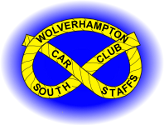From The Timpsonian (the Timpson house magazine) March 1973
THE CASTROL TIMPSON
BY RICHARD HUDSON-EVANS
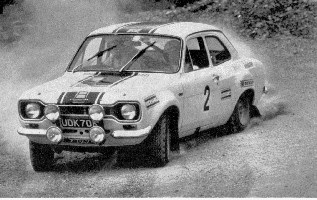
Car 2 leads the charge
Thames Television Motoring Correspondent and a regular broadcaster on BBC radio on Motor sport.
It doesn't seem to matter that the great environmental purge is currently being directed at the motor car. Even the most repressive contributions from the legislators and planners of the highway, byeway and shopping centre seem to have little overall effect. As yet unchallenged, the case for the sheer personal freedom of the motor car continues to be increasingly one of the most fervent.
Indeed, for the foreseeable future, the car and its bustling attendant scene is most certainly here to stay. And as the vast horde of A to B motorists continues to swell, so too does the motor enthusiast cult blossom, catering, as it does, for the equally expanding market of taking the mere convenience of the car a stage further. The great motor bug manifests itself in a bewilderingly varied set of possibilities, from the cliff edge Super League of the jet-setting Grand Prix circus - to the earthy carnival around the cinders of the local Stock Car track. But the principle is the same. More and more people are wanting to take part in sport using all manner of motorised contraptions.
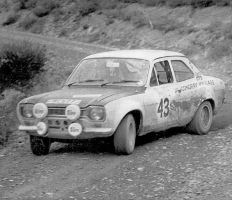
An Escort (left) and an Alpine (below) negotiate a trickey part of the course
The most obvious shop window for motor sport is the racing circuit or stadium. Yet there always seems to be something rather artificial about activities in an arena.
As in any highly professional sport, one realises that a great deal of discipline and organisation is a must. Even so, cars, clinically circulating the same bit of race track, always have a certain contrived air about them.
In any case, such packaged entertainment has really only evolved from those glorious, impractical and sadly, some would say, far off days of yesteryear. Days when Magnificent Men in amazing machines battled through the dust, from town to town, at break-neck speeds. To any nostalgic romantic, there can be nothing to compare, for sheer spectacle, with out and out road racing.
Nowadays, all that is really left of such a gloriously dangerous past is the Targa Florio - just one lone sports car classic that somehow manages to survive - around the highly photogenic, though extremely dangerous Sicilian lanes.
Perhaps it is only in rallying that much of that original adventure remains. Only here do people continue to thrash along over enormous distances, two-up in the manner of yesteryear, the intrepid pilot and his daring riding accomplice.
However, even rallying has had to change. Due to the increasing traffic volumes all over Europe. Even in the remotest areas, more and more restrictions have been levelled against this sector of motor sport.
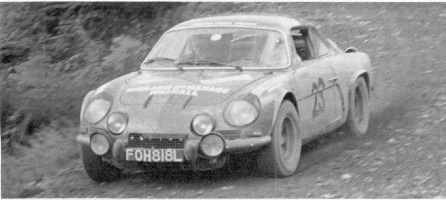
For although purist road rallying does still go on, even in Britain - admittedly strictly within the extremely tightly controlled maze of legislature policed by the RAC's Motor Sport Division - it has to be held well off the beaten track and in the middle of the night. And, quite frankly, as the regulations surrounding it become more and more repressive ultimately one can't help feeling its days are numbered.
A new look rallying has emerged though. One that has a booming future in store, not just for those taking part, but for more and more spectators as well. Rather than being hunted into extinction, it has become `legitimate'. The Special Stage, closed to other road users, has been born.
In fact, nearly all today's premier events are run to the Special Stage formula, being won and lost over a series of such tests. As far as British events go, these are invariably held on Forestry Commission tracks. Each competitor, starting individually, being timed to the nearest second and penalised by the organisers for the amount of time taken over and above their section target times.
Hazardous Tracks
The Castrol Timpson National Car Rally was just such an event, fought out on the hummocky twists and stone-covered going of eleven Welsh forests over a very arduous Saturday, November the eleventh.
And so it was at breakfast time that one hundred and nineteen rally cars mustered at the Carmarthen start. That is after comprehensive scrutineering had been cleared at a local garage; checks being made for sound silencing systems, basic component safety, as well as such compulsory safety accessories as fire extinguishers, and roll-over cages.
Just as the first car pulled out towards Brechfa forest in the wilds of the Brecon Beacons - last year's National Rally Champion no less, Chris Sclater from Sussex, navigated by top rally journalist Martin Holmes - so came the first shower of rain. This was to happen mane times during the long day, making the forestry tracks, already hazardous, even more treacherous for the unwary.
Indeed, first to come unstuck on this, the very first section, was none other than Sclater, the favourite for outright victory. His Escort RS slid wide on a muddy bend, becoming bogged down. Precious minutes ticked away before the luckless crew were able to extract their steed from the scenery and continue, though now well down on time.
In fact, so competitive is Special Stage rallying these days, with only seconds separating the star men, that the leader board was to change dramatically throughout the rally. And as befits a really high pressure event, like the Timpson, the pressure was really on the leading protagonists right from the beginning.
Apart from Sclater giving himself an almost impossible handicap to win back, leading South Welsh rally driver, Jeff Churchill, had a big moment in his Escort too, shooting off the track. Fortunately clearing any trees unscathed, he rushed headlong into the open space of a firebreak.
Churchill's car had hardly come to rest, before he was joined by Birmingham dentist, Malcolm Patrick. His identical Escort did one better. It literally flew off the track, actually skating across Churchill's rear wing and boot, before finishing up alongside.
Patrick hammered on without too great a time loss. While poor old Churchill, now stuck even further in the mud, required much ingenious extricating by spectators before being able to continue. Like many competitors, he was tending to find a near full-race power unit and big wide wheels somewhat of a handful on the narrow, slippery tracks.
As the route rushed around the forests for the rest of the morning on the way to a well-earned lunch halt at Machynleth, a battle royal on Special Stage times raged amongst the leaders.
Special Stages
Such contenders as top Midland crew John Bloxham and Richard Harper were in with a chance, using their factory specification Swedish Saab 94 V4; the very same type of car that won last November's RAC Rally of Great Britain, now of course Europe's toughest rally and one that uses many of the very same forests used by Timpson competitors.
Challenging hard were Welsh rally regulars, Frank Pierson from Whitchurch and Colin Francis, using Frank's well known, well used, but functional (though most effectively prepared) Escort RS 1600.
Then there was the interesting looking Alpine Renault, a glassfibre bodied Grand Tourer from France run by Hereford's John Price. Also very much there was what is thought to be the quickest Mini rallying today, that of Jersey's Pat Ryan, accompanied by Mike Nicholson. Then Ron Clift and Peter Valentine, both from the South East, both immensely experienced, were in yet another hotted up Escort.
As the score sheet now reveals, the crucial fastest times through the various forests were initially well shared out between Bloxham's Saab, Price's Alpine, and Pierson and Sclater's Escorts.
Sclater was obviously now really in the groove. For although John Jago's completely private Escort, from Oxford, did top the list in one forest in the afternoon, it was Sclater who took three fastest times in a row.
However, alas for him, it was to be of no avail. For when all the sums were done, he had just failed to climb back into the top ten. However, he did at least have the profitable consolation of reaping the lion's share of the Special Stage prize fund for fastest times. As usual with such a spectacular sport as rallying, regardless of the weather, hordes of enthusiasts and locals gathered in the woods to see the sideways antics of the experts in action. Whilst behind the scenes, those unsung heroes of the sport, in the form of six hundred unpaid marshals from no less than thirteen Motor Clubs, kept the forestry roads clear, arrowed and timed. If needs be, they were prepared to stick to their posts in all weathers.
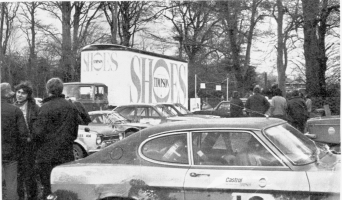
The lunch stop at Machynleth and a chance to compare notes
Darting through the trees only a few minutes before the rally convoy arrived at each forest were the last minute course checking cars, trying out the accuracy of the vital arrowing. These were crewed by the writer and Philip Lloyd, Area Shops Manager for Timpson, weekending on this occasion in the role of Chief Marshall one of the key co-ordinating cogs in the mighty rally mechanism. Also `crowd sweeping' and arrow checking were Assistant Clerks of the Course, John Gibbs and Norman Jones.
Then before, during and after an event of this magnitude, there were the inevitable amounts of administrational paper-work, capably mastered on this occasion by Wilf Davies, the Secretary of the Meeting, assisted by an enthusiastic band of volunteers from the Wolverhampton and South Staffs Car Club.
The vast number of sums necessary to compute an accurate result for all, as quickly as possible after each surviving car struggled into the Shrewsbury finish, were calculated by Peter Donnally's results team. Whilst the supervision of the all-important timing on the Special Stages was in the experienced hands of Timekeepers John Dain and Les Nation.
Drama
The major share of all the 'behind-the-scenes' graft that went into the event was undoubtedly done by Clerk of the Course, Dave Stephenson, from Solihull, one of the country's most experienced rally navigators. He, it was, who designed the permutation of forestry tracks and worked out with the RAC's Rally Authorisation Department how to direct the competitors from forest to forest, with the minimum amount of inconvenience to residents and other road users. This detailed ground work constitutes a gargantuan task, requiring travelling every inch of the route several times, carrying out the public relations work, so vital for the smooth running of a top-line event like the Timpson.
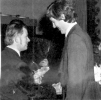
Chris Sclater reaps the lions share of the Special Stage prize fund
Meanwhile back on the event, as darkness fell on the damp track of the Welsh woodlands, the competitor drama reached its peak; the last Stage of all, five miles of Derry and some really glutinous Safari-like mud.
In the lead up to this point, but only just, was Pierson. For his lights had become reduced to a weak glimmer, through alternator troubles and no replacement being at hand. He rushed into the by now near darkness of the section just as early as he was allowed, hoping to gain the very last strains of daylight. But peering through the murky gloom in the inner depths of the wood, his lead slipped away into a final third place - but only by just fifteen seconds.

Pat Ryan and Mike Nicholson collect their well earned lauels and booty from A.C. Simmons
The boggy Derry going was quite obviously to the liking of Ryan, who, at the very last, clinched another win for the legendary Mini, an occurrence sadly all too rare these days. While Price, in his classic Alpine Renault, came second, with an aggregate penalty score, only a mere six seconds slower . . .
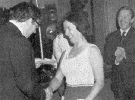
Mrs M Davies takes the Best Lady Driver award
... and so to round off a hectic day's motoring it was back to a lively, bustling, post-rally happening at the Lord Hill in Shrewsbury where Pat Ryan and Mike Nicholson collected their well earned laurels and booty from Timpson Director, Alan Simmons. Whilst Mrs. Maureen Davies, wife of the organising club's Secretary of the Meeting, Wilf, catered for the feminine angle by taking home the Best Lady Driver's award. A case of keeping it in the family!

